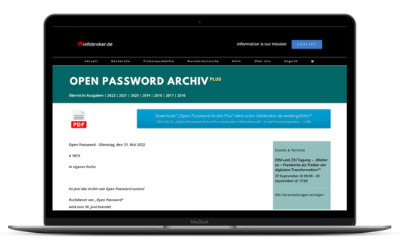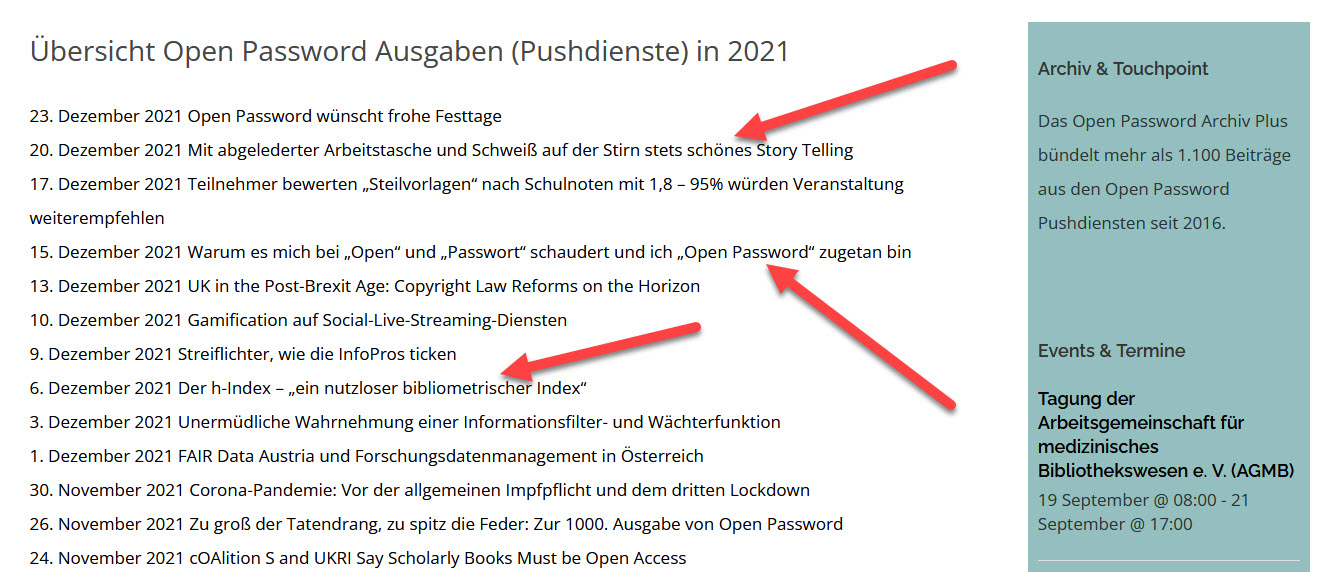Open Password – Freitag, den 26. Mai 2017
#204
Fake News – Public Relations – Corporate Human Rights Benchmark – Risikomanagement – Cloud-Lösungen – Brexit – Anti-Korruption – Yahoo – Compliance – Minesoft – Rob Poolman – Patent Landscape Analysis – Patentfamilien – Competitive Intelligence – Suchstrategien – Viualisierung – PatBase
LexisNexis
Corporate Human Rights Benchmark,
Risiken und Vorzüge von Cloud-Lösungen,
die Datenpanne bei Yahoo
Lexis Nexis hat abermals Blogbeiträge von allgemeinem Interesse publiziert:
10 Tipps zur Bekämpfung von Fake News: https://www.lexisnexis.de/blog/medienbeobachtung/bekaempfung-von-fake-news
Entwicklung moderner PR-Kenntnisse: https://www.lexisnexis.de/blog/medienbeobachtung/entwicklung-moderner-pr-kenntnisse
Die Verbindung zwischen Corporate Human Rights Benchmark und Risikomanagement verstehen: https://www.lexisnexis.de/blog/compliance/corporate-human-rights-benchmark
Compliance: So wägen Sie Risiken und Vorzüge von Cloud-Lösungen ab: https://www.lexisnexis.de/blog/compliance/cloud-loesungen
Brexit und Anti-Korruption: https://www.lexisnexis.de/blog/compliance/untergraebt-der-brexit-den-britischen-kampf-gegen-korruption
Yahoos Datenpanne zeigt Risiken unzureichender Corporate-Compliance-Programme auf: https://www.lexisnexis.de/blog/compliance/yahoo-datenpanne.
Den Ratgeber zur Bekämpfung von Fake News binden wir in Kürze in unsere FakeNews-Debatte ein..
A White Paper
by Minesoft
Patent Landscape Analysis
in Six Simple Steps
Von Rob Poolman
Patent Landscape reports are intended to give a snapshot or overview of the patents in a specific subject area or covering a type of technology. Generally taking 1-2 weeks to complete, a landscape report can cover hundreds or even thousands of patent families. They can be used to visualise and discover existing whitespace in relevant areas, gain actionable competitive intelligence by understanding the current landscape, predict where your market is heading and spot trends in areas of interest to aid investment.
They are a critical step in deciding the R+D, competitive or patent strategy for any company or institution.
In this article, we have outlined 6 simple steps to help you ensure an effective and comprehensive patent landscape analysis.
Define Your Goal
It’s important to understand why you want to do a patent landscaping activity, and to define these goals in advance. Depending on what the end goal is, you may want to address some or all of these questions while conducting your search.
- Is this a growing area of interest?
- What are the fields of current interest?
- Who are the key players?
- Where are the key players filing their inventions?
- Who are the key opinion leaders in this field?
- What is the legal status of the families in this area?
Once you have a clear goal defined, it is time to start with some general research to help you understand the area and define an initial search strategy.
Obtain a Broad Overview
Begin with some general research around the given subject matter. Basic online research using a few relevant keywords, or looking into companies known to be active in the area can uncover useful articles and background information to help prepare your initial search strategy. Having a clear understanding of the area you’re investigating is critical when analysing the final landscape and answering the key questions outlined above.
Studying a selection of basic literature will unearth some high-level keywords, as well as identifying key players that are associated with the technology or subject area you’re landscaping.
Define Your Initial Search Strategy
Now that you have a clear understanding of your area of choice, you can begin to devise an initial search strategy. Start by generating keywords used for the specific technology and build from there. Searching your basic keywords within the title, abstract and claims of patents will help you to discover additional relevant keywords as well as active assignees and inventors. Furthermore, a statistical analysis of the IPC and CPC codes used to classify the initial answer set will identify relevant classification codes to add to your search strategy.
Once you’ve developed an initial search strategy, encompassing keywords, classification codes, assignees and inventors, the search results should be more accurately focused on your subject matter of interest by several limitation steps. This process is difficult and needs to be checked at every stage to ensure that relevant records are not being eliminated.
Results can be narrowed down by limiting the geographical area, removing utility models and design patents, removing irrelevant patent families identified by acronyms used in multiple technology areas, and limiting by publication years. At this juncture, you should have compiled a solid search strategy and be ready to progress to the next stage.
Run Your Initial Search
The appearance of your search string will vary depending on which patent database you’re using. However, it should incorporate a selection of keywords, key assignees and inventors, full text searches, IPC codes, etc.
Once your results come back, take a quick review. Determine the percentage of your answer set which reveals relevant answers and judge whether it’s enough for a reliable patent landscape analysis. Typically, if it’s 80% or more, your search strategy is sound.
Ensure that the most important patents in the specified area are included in your results. You can check this by sorting your answer by “most cited” to reveal which are the most cited publications in the area you’re landscaping and therefore the most significant.
Assuming your initial set meets your criteria, you can use the results of this set to optimise your search strategy. If not, you ’ll need to adjust your search accordingly.
Optimise Your Search Strategy
Improving your initial search requires additional relevant keywords, classification codes, active assignees and inventors. Discover more keywords by reviewing classification code definitions and checking the title and abstract of key patents. Utilise relevant classification codes from the basic keyword answer set to focus your landscape.
Furthermore, you’ll need to exclude any potential sources of irrelevant results, enabling a more comprehensive and clean final landscape search.
Be sure to take advantage of features in your patent database, such as analytics, advanced keyword highlighting and text-mining to enhance the efficiency and effectiveness of your evaluation of patents within your landscape search. Furthermore, utilise any tools within your patent database to clean up your landscape including grouping assignees together and de-duplicating the answer set to focus on patent families, within which all publications describe the same invention.
Now that you’re satisfied with your set of results, you can now visualise your landscape and address the goal/questions that you started with.
Visualise and Review
Visualise your landscape search by generating statistical graphs. By viewing the data from many angles (jurisdiction, year, assignee, inventor, etc.) and at multiple levels (families, priorities, applications, grants, etc.) you can reveal answers to key questions and easily draw some conclusions; ensuring you stay focused on your end goal.
Is this a growing area of interest?
This can be easily identified by simply checking the breakdown of the number of patent publications, patent families or granted documents over time.
What are the current fields of interest?
Which are the top IPC and CPC classification codes? This will signify the areas in which most patents are filed. Alternatively, review the most frequently occurring keyword concepts to discover which key fields are being actively pursued.
Who are the key players?
Analyse the landscape for the most occurring patent assignees can identify the key players and potential collaboration or acquisition opportunities.
Where are the key players filing their inventions?
Find out in which jurisdictions the top players are filing their inventions to unearth the key markets where patent protection in being sought.
Who are the key opinion leaders in this field?
By determining who is the most occurring inventor in your field, you can identify your next employee or partner in developing a technology.
What is the legal status of the families in this area?
Reviewing the landscape by legal status identifies if this area is being actively pursued, where most of the patents are in force or being actively prosecuted. If the area is of lesser interest, most patents will have expired or have been withdrawn.
Conclusion
Regular patent landscaping is crucial for survival in any innovation-driven industry to identify white space, monitor competitor activity and identify acquisition, licencing or collaboration opportunities. Having access to a comprehensive database of global patent data, like PatBase, is a key first step but ensuring a focussed and inclusive search strategy is vital. The 6 simple steps outlined in this article can help any user identify a complete patent landscape and draw the appropriate conclusions.
Next Steps
Selecting a high-quality, comprehensive patent database allows you to execute a thorough landscape search more efficiently and accurately.
PatBase, the online patent database, allows you to optimise the way you search and review patent literature. Trusted by top corporations and law firms worldwide, our users rely on PatBase as a robust and powerful platform from which to search, review, share and analyse business-critical patent information.
Request your two-week free trial today, visit www.discoverpatents.net.
The Author: Rob Poolman PhD, MBA, is a Senior Manager, Innovation and Consulting, at Minesoft Ltd. He has over 15 years of experience in the information industry, most recently managing the NIBR Search and Analytics team at Novartis. He joined Minesoft in 2014 and focuses on spearheading future product development.
Anzeige

FAQ + Hilfe



